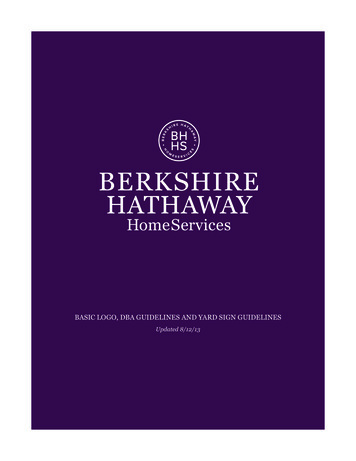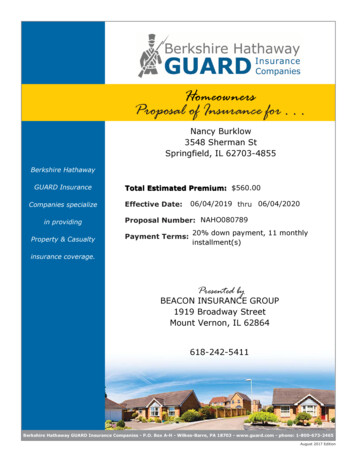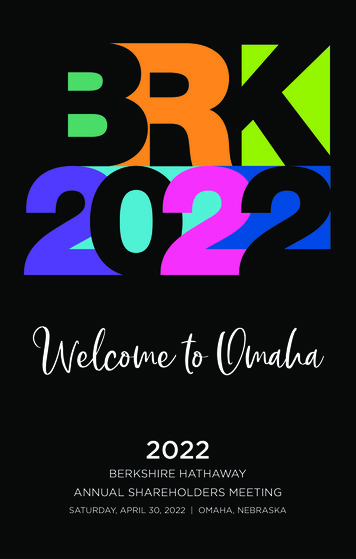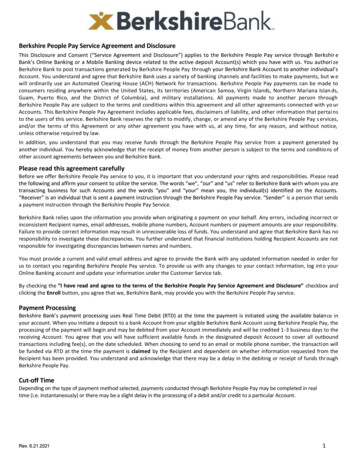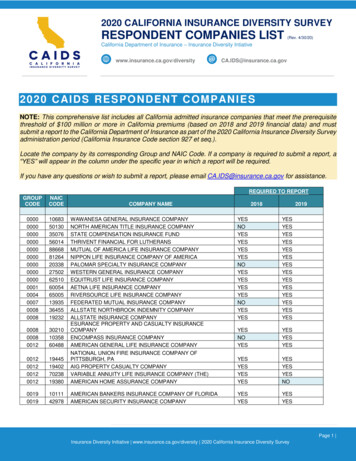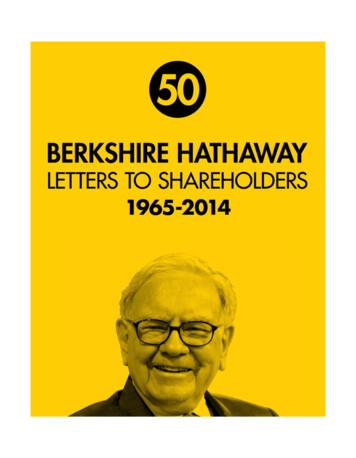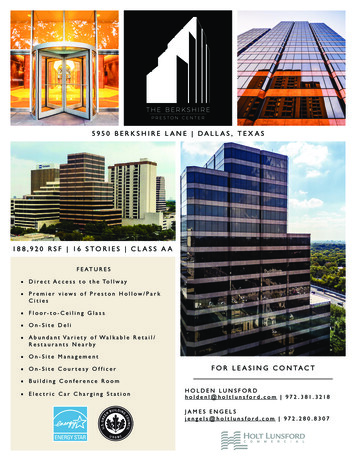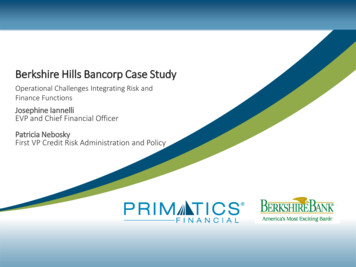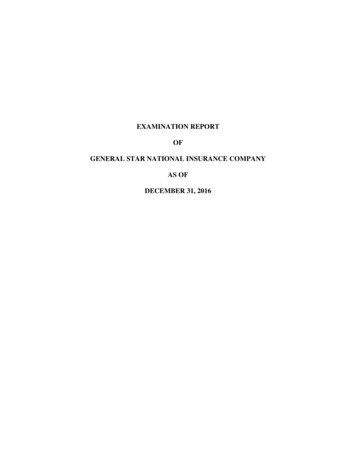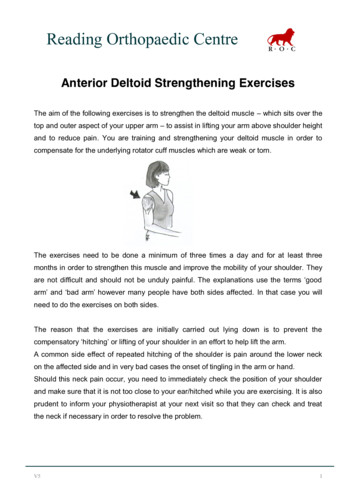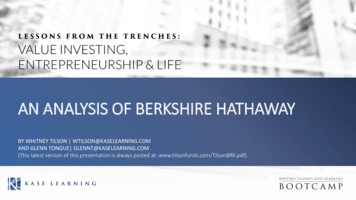
Transcription
AN ANALYSIS OF BERKSHIRE HATHAWAYBY WHITNEY TILSON WTILSON@KASELEARNING.COMAND GLENN TONGUE GLENNT@KASELEARNING.COM(This latest version of this presentation is always posted at: www.tilsonfunds.com/TilsonBRK.pdf)
I CLOSED MY HEDGE FUNDS IN OCTOBER 2017 AND SHORTLY THEREAFTERLAUNCHED KASE LEARNING My parents are both educators, I love to teach, and I’ve done a lot of teaching, writing andmentoring over the years, so it was a natural transition There’s a large global market of sophisticated investors – both professionals and avidamateurs – who want to learn and become better, many of whom want to start/grow theirown investment funds There’s almost nobody teaching high-level investing and fund entrepreneurship–Continuing Legal Education (CLE) and Continuing Medical Education (CME) are major industries, butthere’s nothing comparable for investors My long-time partner at Kase Capital, Glenn Tongue, has rejoined me We seek to capture all of the lessons we learned in nearly two decades in the hedge fundtrenches, both as investors and entrepreneurs, and impart that knowledge to others so theycan stand on our shoulders and achieve even greater success
INVESTING IS A BATTLE The reason we call Kase Learning’s core program Lessons from the Trenches is thatinvesting is a battleThis long bull market combined with the rise of indexing and the increasingsophistication of supercomputers has made the job of investors and fundmanagers much harderThus, to succeed you must be better than ever before: do even more in-depthresearch, do better analysis, be more patient and disciplined, etc.Most importantly, you have to get on a steep learning/experience curve and stayon it for a lifetimeThere are only two ways to get experience: learning from veterans (like us) orstumbling around on your own, making mistakes and getting scars on your backWhich do you prefer?
REAL-WORLD EXPERIENCES & CASE STUDIES We are not interested in academic theories; we only teach via case studies rootedin our own real-world experiencesThere are many value investing programs and books that teach the basics: intrinsicvalue, margin of safety and sustainable competitive advantage; various valuationmethodologies; how to do a discounted cash flow, etc.But understanding these topics is far from what is truly necessary to successfullynavigate today’s difficult marketsWe teach dozens of lessons we learned – in many cases, the hard way – over twodecades in the trenches: how to find great stocks, avoid value traps, manage aportfolio effectively, short sell, be an activist, control one’s emotions, hire the rightpeople at the right time, make a name for yourself, raise money, communicate wellwith investors, and much more
WE FOCUS ON SUCCESSES AND MISTAKES During our years at Harvard and Wharton business schools, we read hundreds ofcase studies and pretty much every one featured a heroic protagonist, facing adifficult issue, but almost every time reaching the right decision and achievinggreat success– We can’t recall a single one in which the protagonist made wrong decisions andscrewed it all up This is not how the world works — everyone makes mistakes and suffers setbacks We believe that it’s just as important to teach and learn from mistakes, so wehonestly share the many we made so that others can avoid them– “Only a fool learns from his own mistakes. The wise man learns from the mistakes ofothers.” – Otto von Bismarck
HOW WE THINK ABOUT INVESTING We are value investors, so anyone looking for hot stock tips or advice onhow to get rich quick should not take our programs That said, we are primarily “make money” investors, so we define valuebroadly– We believe that value can be found in many places, even among growthstocks, so we teach case studies that include Netflix, Alphabet, Facebookand SodaStream
WE ALSO TEACH ENTREPRENEURSHIP The hedge fund industry is now very large, but at its core it’s still anapprenticeship business: young investors learn the business from grizzledveterans But what about the 99% of investors who dream of being the next WarrenBuffett or Julian Robertson, but aren’t lucky enough to land a job at anestablished firm? How are they supposed to learn what they need to know to have areasonable chance of success?
KASE LEARNING’S THREE CORE PROGRAMS1.A three-day Lessons from the Trenches: Value Investing Bootcamp2.A one-day seminar on How to Launch and Build an Investment Fund3.A one-day Advanced Seminar on Short Selling They can be taken individually or in any combination, though most choose to take all three We teach them in person over five 12-hour days (3 1 1) and also via live webinars: 15 2½hour modules (9 for the bootcamp and 3 for each seminar) that we teach live every day from7:00-9:30am EST Our next in-person seminar is in NYC the week of September 24-28 Our next webinars are How to Launch and Build an Investment Fund (Sept. 14, 17 and 18) andan Advanced Seminar on Short Selling (Sept. 19-21); then, we’re teaching all three programsvia webinar from Oct. 29-Nov. 16
KASE LEARNING’S CONFERENCEON SHORT SELLING ON DEC. 3 This long bull market has inflicted absolute carnage on short books, and even seasonedveterans are throwing in the towelThis capitulation, however, combined with the increasing level of overvaluation,complacency, hype and even fraud in our markets, spells opportunity for courageous shortsellersOn May 3rd in New York City, Kase Learning hosted the first-ever conference dedicatedentirely to short selling, which featured 22 of the world’s top practitioners, including DavidEinhorn and Carson Block, who shared their wisdom, lessons learned, and best, actionableshort ideasThe conference was such a success that we’re hosting another one in NYC on Monday,December 3Contact Kase Learning for an early-bird discount
TESTIMONIALS “The greatest teacher of investing was Benjamin Graham. He was followed by Warren Buffett and CharlieMunger. Believe me, the third person is Whitney Tilson. He’s a natural teacher.” – Chris Stavrou, StavrouPartners (watch the video here) “It was a wonderful, almost life-changing experience. In a nutshell, it felt like an intensive infusion ofwisdom and practical advice. I also really enjoyed meeting the people in the group who were, withoutexception, intelligent, hard-working, open-minded and friendly.” – Gabriel Grego, Quintessential CapitalManagement LLC “I would absolutely recommend this seminar to anyone aspiring to run their own investment managementbusiness. What is taught in this seminar is pure gold. It’s not taught anywhere else and there aren’t thatmany people in the world who really understand what it takes to raise a billion-dollar fund. I think that thisis an incredible product. It’s not really a proxy for business school or Columbia’s value investing program.It’s more advanced and for someone farther ahead in their career. There are so many start-up, emergingmanagers who have no idea how to raise money and where to start.”
TESTIMONIALS (2) “As a young analyst trying to get ahead, this was the shot in the arm I needed. I know the hedge fundworld has become increasingly difficult and competitive, so I’ve been looking for any leg up I could find –and the seminar delivered, far surpassing my expectations. I was blown away by the one-on-one,personalized attention and can’t imagine a better way to learn than from Whitney’s case-based format. Ileft the seminar a better investor, entrepreneur and, unexpectedly, better person. Highly recommended!”– Jeremy Lichtman, SevenSaoi Capital“At the beginning of Whitney’s course, I didn’t know what to expect and had little idea of how to set upand market my business, but after only a few days it’s not an understatement that the seminar will makeme millions of dollars and save me a great deal of trouble. Whitney laid out everything he did right inlaunching and growing his fund for more than a decade and then, perhaps more importantly, very honestlydetailed what he did wrong. Through his connections, we also met with investors at the very top of theindustry who were very generous with their time and open to all questions. Lastly, I now have 12 friendswho are very bright and at a similar point in their careers who I can bounce ideas off of, a clear plan forhow to market and grow the business (it’s encouraging when you hear Bill Ackman tell you he likes yourplan), and most importantly I know what pitfalls to avoid.” – Angelo Martorell, Martorell Capital Partners
ARTICLES BY/ABOUT KASE LEARNING So You Want to Be a Hedge Fund Star?, Barron’s, 5/11/18– Want to Run a High-Flying Hedge Fund? Don’t Be a Cheapskate, WSJ, 6/26/18– y-tilson-on-the-rise-and-fall-of-kase-capitalHow My Success Led to My Fall, Yahoo Finance, 5/23/18– itney Tilson On The Rise And Fall Of Kase Capital, Forbes, 5/1/18– ge-fund-dont-be-a-cheapskate-1530021600The Last Days of Whitney Tilson’s Kase Capital, Institutional Investor, 3/20/18– s/success-led-fall-174512177.htmlThe Launch Of Kase Learning And Running A Hedge Fund, Seeking Alpha interview, unning-hedge-fund
FURTHER INFORMATION Further information is at www.kaselearning.com or call (212) 265-4510 Email me at WTilson@kaselearning.com if you would like to be added tomy investing email list and/or have questions or comments Follow Kase Learning on:
AN ANALYSIS OFBERKSHIRE HATHAWAY
THE BASICS Stock price (9/12/18): 322,910 ( 215 for B shares)Shares outstanding: 1.64 millionMarket cap: 530 billionTotal assets, equity, revenue and float (Q2 ‘18): 712B, 362B, 241B and 116B,respectivelyBook value per share (Q2 '18): 217,677P/B: 1.48xBerkshire Hathaway today is the 9th largest company in the world (and 3rd largest in theU.S.) by revenuesAt today’s price, we’re not pounding the table on the stock, but if you want to sleep wellat night and have a very good chance of beating the S&P over time, especially if themarket does poorly, then Berkshire is a great addition to a conservative portfolio.
HISTORY Berkshire Hathaway today does not resemble the company that Buffettbought into during the 1960s It was a leading New England-based textile company, with investmentappeal as a classic Ben Graham-style "net-net" Buffett took control of Berkshire on May 10, 1965 At that time, the company had a market value of about 18 million andshareholder's equity of about 22 million
THE BERKSHIRE HATHAWAY EMPIRE TODAYLargest Stakes in Public Companies ( B)CompanyAppleWells FargoBank of AmericaKraft HeinzCoca-ColaAmerican ExpressPhillips 66U.S. BancorpMoody’sBank of NYDelta AirlinesGoldman SachsSouthwest AirlinesCharter CommGeneral ce 183.83 52.41 29.30 58.01 42.36 98.35 115.61 50.34 166.31 54.49 52.34 234.94 52.78 276.07 36.71 6.45Value 44,434 25,290 20,510 18,879 16,944 14,911 8,623 5,228 4,103 2,905 2,780 2,676 2,515 1,874 1,635 1,451 24,294 199,052Notes: Share count as of 12/31/17 13-F plus 75M AAPL; Stock prices as of 5/4/18.
THE BERKSHIRE HATHAWAY EMPIRE TODAY (2)Revenues (2015)Source: UBS analyst report, 3/28/16.
BERKSHIRE’S NON-INVESTMENT INCOMEHAS SOARED OVER TIME 25InvestmentInsuranceNon-Insurance 20( B) 15 10 5 0200420052006200720082009201020112012201320142015- 5Note: Insurance losses in 2017 were primarily due to “several significant catastrophe loss events occurring during the year includinghurricanes Harvey, Irma and Maria, an earthquake in Mexico, a cyclone in Australia and wildfires in California” and an increase in“ultimate claim liability estimates related to the aggregate excess-of-loss retroactive reinsurance agreement with AIG.”20162017
BERKSHIRE’S FLOAT HAS GROWN ENORMOUSLY 140AIG deal 120( B) 100Equitas deal 80 60GenRe acquisition 40 20 0
BERKSHIRE’S Q2 EARNINGS WERE EXTRAORDINARY Net earnings per share almost tripled from 4.3 billion to 12.0 billion. These headline numbers were impacted by a number of items, the most important of which was a new accounting rule thatrequires changes in the value of equity holdings, both realized and unrealized, to be shown in the income statement(previously the income statement only reflected realized gains). In addition, Berkshire is a major beneficiary of the lowercorporate tax rate for U.S. corporations (its tax rate fell from 29% in Q2 ‘17 to 20% in Q2 ’18). But even excluding these two items, Berkshire’s pretax operating earnings soared 67% (!) from 4.1 billion to 6.9 billion. Thestandout was the insurance group, led by GEICO, where pretax income jumped more than 5x from 119 million to 673million. Overall, insurance underwriting profits were 1.2 billion vs. - 24 million in Q2 ’17. Investment income was up almost 8%, increasing to a run-rate of over 5 billion annually, and the pretax profit of all otheroperating businesses, the largest of which are manufacturing and BNSF, grew 9%. Other items of note:–Float grew by 2 billion year to date to 116 billion.–Book value per share grew to 217,677 per share, up 3% year to date.–No shares were bought back under the repurchase program, but subsequent to quarter end, Buffett said he’d bought some back.–Cash and investments per share were virtually unchanged from the end of 2017.
DESPITE BEING VERY CONSERVATIVELY POSITIONED, THESTOCK HAS KEPT PACE WITH THIS LONG BULL MARKET
BUFFETT, COMBS & WESCHLER WERE PUTTINGCASH TO WORK AT A HEALTHY CLIP UNTIL 2017 35 30 25AcquisitionsNet Stock PurchasesBurlington Northern( 26.5B for 77.5% BRK didn’t own; 16B in cash, balance in stock)BofA ( 5B) &IBM ( 10.9B)PCP( 33B)Heinz ( 12.3, 3.0, and 5.3Bin 2013-15) 20 15ISCAR ( 4B for 80%)& PacifiCorp ( 5.1B)Lubrizol ( 8.7B) 10 5 0- 51997 1998 1999 2000 2001 2002 2003 2004 2005 2006 2007 2008 2009 2010 2011 2012 2013 2014 2015 2016 2017- 10- 15 High valuations are keeping Buffett, Combs and Weschler on the sidelines these daysBut markets have a way of presenting big opportunities on short notice– Junk bonds in 2002, chaos in 2008– Buffett has reduced the average maturity of Berkshire’s bond portfolio so hecan act quickly
VALUING BERKSHIRE"Over the years we've attempt[ed] to increase our marketable investments in wonderful businesses, whilesimultaneously trying to buy similar businesses in their entirety." – 1995 Annual Letter"In our last two annual reports, we furnished you a table that Charlie and I believe is central to estimating Berkshire'sintrinsic value. In the updated version of that table, which follows, we trace our two key components of value. Thefirst column lists our per-share ownership of investments (including cash and equivalents) and the second columnshows our per-share earnings from Berkshire's operating businesses before taxes and purchase-accountingadjustments, but after all interest and corporate expenses. The second column excludes all dividends, interest andcapital gains that we realized from the investments presented in the first column." – 1997 Annual Letter"In effect, the columns show what Berkshire would look like were it split into two parts, with one entity holding ourinvestments and the other operating all of our businesses and bearing all corporate costs." – 1997 Annual Letter
BUFFETT'S COMMENTS ON BERKSHIRE'S VALUATIONLEAD TO AN IMPLIED HISTORICAL MULTIPLIER OF 12XPre-tax EPSExcluding All Year-EndInvestments Income FromStockIntrinsic ImpliedYear Per ShareInvestmentsPriceValue Multiplier1996 28,500 421 34,100 34,100131997 38,043 718 46,000 46,000111998 47,647 474 70,000 54,000131999 47,339- 458 56,100 60,000 1996 Annual Letter: "Today's price/value relationship is both much different from what it was a year ago and, as Charlie and I see it,more appropriate."1997 Annual Letter: "Berkshire's intrinsic value grew at nearly the same pace as book value" (book 34.1%)1998 Annual Letter: "Though Berkshire's intrinsic value grew very substantially in 1998, the gain fell well short of the 48.3%recorded for book value." (Assume a 15-20% increase in intrinsic value.)1999 Annual Letter: "A repurchase of, say, 2% of a company's shares at a 25% discount from per-share intrinsic value.We will notrepurchase shares unless we believe Berkshire stock is selling well below intrinsic value, conservatively calculated.Recently, whenthe A shares fell below 45,000, we considered making repurchases."
BERKSHIRE’S EARNINGS AND INVESTMENTSPER SHARE HAVE STEADILY RISEN 250,000 14,000Investments Per Share (left axis)Pre-tax EPS (right axis) 12,000 200,000 10,000 8,000 150,000 6,000 100,000 4,000 2,000 50,000 0 0- 01220132014Note: We subtract insurance earnings, but then add back a conservative estimate of normalized earnings from Berkshire'sinsurance businesses: half of the 2 billion of average annual profit over the 14 years prior to 2017, equal to 608/share.201520162017
BERKSHIRE’S INTRINSIC VALUE: 2001-2017Year 220132014201520162017Cash andInvestmentsPer Share 1 47,460 52,507 62,273 66,967 74,129 80,636 90,343 75,912 91,091 94,730 98,366 113,786 129,253 140,123 159,794 168,099 201,317Pre-tax EPSExcluding AllIncome From Intrinsic ValueInvestments 2Per Share3- 1,289 64,000 1,479 70,255 2,912 97,217 3,003 103,003 3,600 117,329 5,300 144,236 5,600 157,543 5,727 121,728 3,571 119,659 7,200 152,330 8,036 178,725 9,124 205,027 10,013 229,381 11,260 252,720 12,060 280,396 12,322 291,323 12,903 343,253SubsequentYear StockPrice Range 59,600- 78,500 60,600- 84,700 81,000- 95,700 78,800- 92,000 85,700- 114,200 107,200- 151,650 84,000- 147,000 70,050- 108,100 97,205- 128,730 98,952- 131,463 114,500- 134,060 139,610- 178,275 163,038- 229,374 192,200- 224,880 189,640- 249,711 240,280- 299,360?1. In every annual letter through 2015, Buffett disclosed both pre-tax earnings as well as cash and investments per share.” Since then, we estimate them.2. We subtract insurance earnings, but then add back a conservative estimate of normalized earnings from Berkshire's insurance businesses: half of the 2 billion of average annual profit over the 14 years prior to 2017,equal to 608/share.3. Historically we believe Buffett used a 12x multiple, but given compressed multiples during the downturn, we used 8x in 2008-2010 , 10x from 2011-2016, and 11x in 2017 (due to the benefits of the tax reform billpassed at the end of 2017).Though bookvalue only rose2.8% in the firsthalf of 2018, weestimate thatintrinsic value haslikely risen 6% asof midSeptember, solet’s call it 365,000
BERKSHIRE IS TRADING 12% BELOWITS INTRINSIC VALUE 350k 300k 250kIntrinsic value* 200k 150k 100k 50k 01996199820002002200420062008201020122014* Investments per share plus 12x pre-tax earnings per share through 2007, then an 8x multiple from 2008-2010, a 10xmultiple from 2011-2016, and an 11x multiple in 2017.20162017
12-MONTH INVESTMENT RETURN Current intrinsic value: 365,000/sharePlus 6% annual growth of intrinsic value of the businessPlus 10,000/share cash build over next 12 monthsEquals intrinsic value in one year of 397,00023% above today's price
CATALYSTS Continued earnings growth of operating businessesLikelihood of meaningful acquisitionsNew stock investmentsAdditional cash buildShare repurchases (especially now that Buffett has abandoned the 1.2xbook value limit and has repurchased stock above 1.4x)
RISKS: WHO WILL REPLACE BUFFETT? When Buffett is no longer running Berkshire, his job will be split into two parts: one CEO, who hasnot been named (likely Greg Abel and/or Ajit Jain, both of whom were just added to Berkshire’sboard), and a small number of CIOs (Chief Investment Officers)–– A CEO successor (and two backups) have been identified, but not publicly namedTwo CIOs have been named already, Todd Combs and Ted Weschler, both of whom are excellent investorsNevertheless, Buffett is irreplaceable and it will be a significant loss when he no longer runsBerkshire for a number of reasons:––––There is no investor with Buffett's experience, wisdom and track record, so his successors' decisionsregarding the purchases of both stocks and entire businesses might not be as goodMost of the 80 managers of Berkshire's operating subsidiaries are wealthy and don't need to work, butnevertheless work extremely hard and almost never leave thanks to Buffett's "halo" and superb managerialskills. Will this remain the case under his successors?Buffett's relationships and reputation are unrivaled so he is sometimes offered deals and terms that are notoffered to any other investor – and might not be offered to his successorsBeing offered investment opportunities (especially on terms/prices not available to anyone else) also appliesto buying companies outright. There's a high degree of prestige in selling one's business to Buffett (aboveand beyond the advantages of selling to Berkshire). For example, the owners of Iscar could surely havegotten a higher price had they taken the business public or sold it to an LBO firm
AREN'T WE CONCERNED ABOUT THEUNCERTAINTY OF BERKSHIRE AFTER BUFFETT?Answer: Not really, for three primary reasons:1. Buffett isn't going anywhere anytime soon. We think it's at least 75% likely that Buffettwill be running Berkshire for five more years Buffett turned 88 on Aug. 30th, 2018, is in excellent health, and loves his jobThere are no signs that he is slowing down mentally – in fact, he appears to be getting better with age A life expectancy calculator (http://calculator.livingto100.com) shows that Buffett is likely to liveto age 94 – and we'd bet on the over2. The stock is undervalued based on our estimate of intrinsic value, which does not includeany Buffett premium We simply take investments/share and add the value of the operating businesses, based on aconservative multiple of their normalized earningsThe value of the cash and bonds won't change, and Wells Fargo, Kraft Heinz, Coke, AmericanExpress, Burlington Northern, GEICO, etc. will continue to generate robust earnings even afterBuffett is no longer running Berkshire3. Buffett has built a powerful culture that is likely to endure
WHY DOESN'T BUFFETT IDENTIFY HISSUCCESSOR NOW?We agree with Buffett's decision not to name his successor for three reasons:1. It would place enormous pressure and expectations on this person, which isunnecessary and counterproductive;2. It might be demotivating for the candidates who were not chosen; and3. Who knows what will happen between now and the time that a successortakes over (which could be more than a decade)?–––Maybe the current designee falls ill, leaves Berkshire, performs poorly, or makes aterrible mistake (e.g., David Sokol)Or what if another candidate (perhaps one of the two backup successors today)performs incredibly well, or Berkshire acquires a business with a fantastic CEO, andBuffett and the board decide that another candidate is better?By not naming Buffett’s successor now, Buffett and the board will be able to switchtheir choice without the second-guessing and media circus that would occur if thesuccessor had been named
THE REAL BUFFETT RISK Buffett is often asked (as are we): "What would happen to the company (andstock) if you got hit by a bus (i.e., die suddenly)?"– If it happened tomorrow, our best guess is that the stock would fall 15% (which might giveBerkshire the opportunity to buy back a lot of stock)– But this isn't likely. Not to be morbid, but most people don't die suddenly from something likean accident or heart attack, but rather die slowly: their bodies (and sometimes minds) graduallydeteriorate– A far greater risk to Berkshire shareholders is that Buffett begins to lose it mentally and startsmaking bad investment decisions, but doesn't recognize it (or refuses to acknowledge itbecause he loves his work so much) and the board won't "take away the keys", perhapsrationalizing that a diminished Buffett is still better than anyone else– Buffett is aware of this risk and has instructed Berkshire's board members, both publicly andprivately, that their most important job is to "take away the keys" if they see him losing it– We trust that both Buffett and the board will act rationally, but also view it as our job toindependently observe and evaluate Buffett to make sure we're comfortable that he's still atthe top of his game. Today, we think he's never been better
BERKSHIRE'S CULTURE IS POWERFUL AND UNIQUE:“A SEAMLESS WEB OF DESERVED TRUST” Berkshire operates via extreme decentralization: though it is one of the largest businesses in theworld with approximately 377,000 employees, only 26 of them are at headquarters in Omaha– There is no general counsel or human resources department"By the standards of the rest of the world, we overtrust. So far it has worked very well for us. Somewould see it as weakness." – Charlie Munger, 5/14"A lot of people think if you just had more process and more compliance — checks and doublechecks and so forth — you could create a better result in the world. Well, Berkshire has hadpractically no process. We had hardly any internal auditing until they forced it on us. We just try tooperate in a seamless web of deserved trust and be careful whom we trust." – Munger, 5/07"We will have a problem of some sort at some time 300,000 people are not all going to behaveproperly all the time." – Warren Buffett, 5/14"Behavioral scientists and psychologists have long contended that 'trust' is, to some degree, one ofthe most powerful forces within organizations. Mr. Munger and Mr. Buffett argue that with the rightbasic controls, finding trustworthy managers and giving them an enormous amount of leewaycreates more value than if they are forced to constantly look over their shoulders at humanresources departments and lawyers monitoring their every move." – NY Times, 5/5/14
WE THINK BERKSHIRE AFTER BUFFETT WILLBE LIKE APPLE AFTER JOBS The most comparable example of a business that, like Berkshire, is closely associatedwith its legendary founder and CEO is Apple–––As Steve Jobs' health began to fail, he assumed fewer day-to-day responsibilities, passing them to toplieutenantsJobs resigned as CEO on Aug. 24, 2011 and died exactly six weeks laterApple's stock declined less than 1% on the first trading days after both his retirement and death, andhas more than quadrupled since then as this chart shows:
OTHER RISKS The single biggest risk is that as Berkshire gets larger and Buffett gets older,investors value the stock at a lower and lower multiple of earnings andbook value, such that even if intrinsic value continues to grow, the stockgoes nowhere for an extended period A recession impacts Berkshire's earnings and stock portfolio materially A very large investment goes awry A major super-cat event costs Berkshire many billions
CONCLUSION: BERKSHIRE HAS EVERYTHING WE LOOK FOR IN ASTOCK: IT’S SAFE, CHEAP AND GROWING AT A HEALTHY RATE Extremely safe: Berkshire's huge hoard of liquid assets, the quality anddiversity of its businesses, the fact that much of its earnings (primarilyinsurance) aren't tied to the economic cycle, and the conservative way inwhich it's managed all protect Berkshire's intrinsic value, while the sharerepurchase program provides downside protection to the stock Upside: trading 12% below intrinsic value (without giving any credit toimmense optionality), with 23% upside over the next year Growing: Intrinsic value is growing at roughly 6-8% annually
APPENDIX
EARNINGS BY YEAREarnings before taxes*Insurance Group:GEICOGeneral ReBerkshire Reinsurance GroupBerkshire H. Primary GroupInvestment IncomeTotal Insurance Oper. 5,21425,87121,876Non-Insurance Businesses:**Burlington Northern Santa FeBerkshire Hathaway EnergyMcLane CompanyManufacturingService & RetailingFinance and financial productsTotal Non-Insur. Oper. 3,2971,1576,1591,7742324363,2791,0066,727Total Operating Income7,4406,97814,31314,859Note: In 2017, Berkshire consolidated General Re and Berkshire Reinsurance Group, so the breakdown is estimated based on the prior year’s split.* In 2010, Berkshire changed this table from "Earnings before income taxes, noncontrolling interests and equity method earnings" to "Earnings before income taxes".** Non-insurance businesses were recategorized in 2014, so figures prior to 2012 are not comparable.
BERKSHIRE’S SHARE REPURCHASE PROGRAM (1) On September 26, 2011, Berkshire announced the first formal share repurchase programin Berkshire's history, and only the second time Buffett has ever offered to buy backstockIt's unusual in three ways:1.2.3. There's no time limitThere's no dollar capBuffett set a price: " no higher than a 10% premium over the then-current book value of theshares
Berkshire Hathaway today does not resemble the company that Buffett bought into during the 1960s It was a leading New England-based textile company, with investment appeal as a classic Ben Graham-style "net-net" Buffett took control of Berkshire on May 10, 1965 At that time, the company had a market value of about 18 million and
